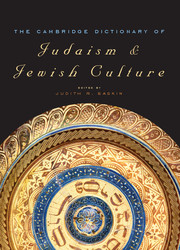Book contents
B
Published online by Cambridge University Press: 05 August 2014
Summary
Baal: See CANAAN, CANAANITE: CANAANITE MYTHOLOGY
Baal Shem, “Master of the Holy Name,” is a term used in medieval and Early Modern times to denote a master of magical powers who employed holy names, divine or angelic, for supernatural purposes. The earliest citation for this term is an epistle of *Hai ben Sherira *Gaon of *Babylonia. The twelfth-century Judah the Pious of Regensburg, a major figure in the pietist *Ḥ asidei Ashkenaz, described a certain Rabbi Joseph as a master of holy names who used his powers to move miraculously from place to place. Several scholars, poets, and halakhists were described by this title in the Middle Ages, but beginning in the sixteenth century it was most commonly applied to mystics, healers, and magicians in Central and Eastern Europe. Among them was R. Joel Baal Shem of Zamoscs, who is credited with treatises dealing with *magic and popular *medicine. The eighteenth-century Shmuel Jacob Ḥayyim Falk was known as the Baal Shem of London. R. Adam Baal Shem of Bingen, a seventeenth-century figure, was later described as the mysterious teacher of the founder of the Ḥasidic movement, R. Israel *Baal Shem Tov (the Besht). There is no real difference in meaning between the terms baal shem and baal shem tov (“Master of the Good Name”).
- Type
- Chapter
- Information
- The Cambridge Dictionary of Judaism and Jewish Culture , pp. 49 - 87Publisher: Cambridge University PressPrint publication year: 2011



